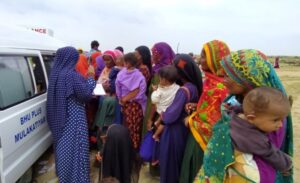Around 33 million people affected by floods in Pakistan are now vulnerable to various diseases. Millions need immediate assistance, especially as floods have damaged health facilities and the country faces outbreaks of several diseases like diarrhoea, dengue and COVID-19.
By Zofeen Ebrahim
Amid unprecedented floods which have affected 33 million people and damaged nearly 900 health facilities, Pakistan faces the risk of widespread outbreaks of diseases, including diarrhoea, dengue, malaria, polio and COVID-19.
The floods have killed more than 1,300 people since 14 June and injured over 12,000, according to the country’s National Disaster Management Authority. The provinces of Sindh and Balochistan are the worst affected with floodwaters engulfing entire villages and wiping out standing crops.
Mirza Nasir-ud-Din Mashhood Ahmad, special secretary at the Ministry of National Health Services, told SciDev.Net that with most health facilities damaged in the worst-affected districts, outbreaks of vector-borne diseases such as malaria and dengue are “imminent in the next few weeks”.
Ahmad said Sindh is the worst affected as the waters here “will not dry for another three to four months”, hampering rehabilitation work and the restoration of health facilities. The province faces a “health emergency”, with the floods limiting access to a vulnerable population and worsening an already ailing health system, he added.
Indrika Ratwatte, director for Asia and the Pacific at the UN Refugee Agency (UNHCR), says this will likely worsen conditions for nearly half a million displaced people and force more to abandon their homes.
“People are facing many challenges in the informal settlements, camped along roadsides to escape surrounding flood waters, setting up shelters with whatever resources they have,” said Ratwatte, urging the international community to step up its support.
Outbreaks reported
The World Health Organization warned that ongoing disease outbreaks in Pakistan including diarrhoea, dengue fever, malaria, polio and COVID-19 are being exacerbated, particularly in the camps and places where water and sanitation facilities have been damaged.
Public health in Pakistan was already considered compromised before the flood. About 38 per cent of children under five are stunted and the country has the world’s second-highest global burden of hepatitis C.
With 116 of Pakistan’s 154 districts impacted by the floods and a third of the country submerged, many immunisation programmes have been disrupted.
“Our vaccinators are working diligently to ensure that routine immunisation continues in the flood-affected districts where health facilities have been damaged,” said Muhammad Ahmed Kazi, director general of the Federal Directorate of Immunisation. “Immunisation is a priority and we must reach children in affected districts with vaccines, especially for diseases like rotavirus, typhoid and measles,” he told SciDev.Net.
“Relief and rehabilitation in displacement settlements will remain a challenge; already disease outbreaks are being reported from most affected areas,” said Arif Jabbar Khan, country director of WaterAid Pakistan, adding that the risk of disease outbreaks will continue as long as people remain displaced. An estimated 500,000 people are currently sheltered in camps.

Women, babies at risk
Khan said when people return to their homes they are likely to encounter deteriorated conditions, including contaminated water sources. “It is important that the water sources at the household and institutional levels are restored and decontaminated on an urgent basis,” he said.
The camps set up to provide emergency shelter also face huge challenges. Maria Mushtaq who cooks and serves meals for internally displaced people in the Khairpur district of Sindh, said: “Even in the better organised camps functioning out of school buildings, the washrooms and latrines are not enough to cater to the huge numbers. Despite being cleaned every day, these camps are swarming with mosquitoes and flies.”
Of the 6.4 million people in need of humanitarian assistance in Sindh, more than 1.6 million are women of childbearing age, said Sindh Health Minister, Azra Pechuho. He told journalists that there were at least 47,000 displaced, pregnant women at different camps around the province.
The UN Population Fund has estimated that there are 650,000 pregnant women in the flood-affected areas of Pakistan, in need of skilled birth attendants, newborn care and support. Of these, about 73,000 are due to deliver this month. With almost one million houses damaged, the UN agency warns that women and girls are at increased risk of gender-based violence.
The floods were caused by heavy torrential rains since June. The Pakistan Meterological Department’s monthly summary for August termed it the “wettest August since 1961”. The monthly summary for July said that average rainfall in Balochistan was 450 per cent above average and 307 per cent above average in Sindh.
This piece has been sourced from SciDev.Net

